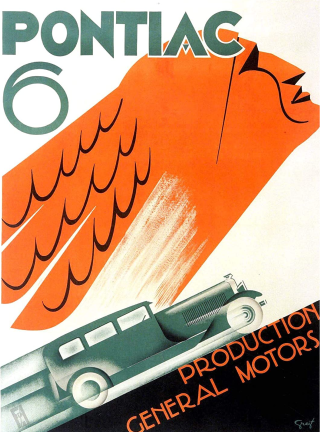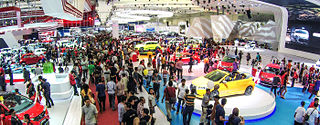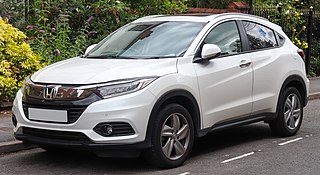Related Research Articles

Minivan is a car classification for vehicles designed to transport passengers in the rear seating row(s), with reconfigurable seats in two or three rows. The equivalent classification in Europe is MPV . In Southeast Asia, the equivalent classification is Asian Utility Vehicle (AUV).

The automotive industry comprises a wide range of companies and organizations involved in the design, development, manufacturing, marketing, selling, repairing, and modifying of motor vehicles. It is one of the world's largest industries by revenue. It is also the industry with the highest spending on research & development per firm.
The automotive industry in the United Kingdom is now best known for premium and sports car marques including Aston Martin, Bentley, Caterham Cars, Daimler, Jaguar, Lagonda, Land Rover, Lister Cars, Lotus, McLaren, MG, Mini, Morgan and Rolls-Royce. Volume car manufacturers with a major presence in the UK include Nissan, Toyota and Vauxhall Motors. Commercial vehicle manufacturers active in the UK include Alexander Dennis, Ford, IBC Vehicles, Leyland Trucks and London Electric Vehicle Company.

Isuzu Motors Ltd., commonly known as Isuzu, is a Japanese multinational automobile manufacturer headquartered in Nishi-ku, Yokohama, Japan. Its principal activity is the production, marketing and sale of Isuzu commercial vehicles and diesel engines.

In the automotive industry, rebadging is a form of market segmentation used by automobile manufacturers around the world. To allow for product differentiation without designing or engineering a new model or brand, a manufacturer creates a distinct automobile by applying a new "badge" or trademark to an existing product line.
Captive import is a marketing term and a strategy for a vehicle that is foreign-built and sold under the name of an importer or by a domestic automaker through its own dealer distribution system.

Subcompact car is a North American classification for cars smaller than a compact car. It is broadly equivalent to the B-segment (Europe), supermini or A0-class (China) classifications.

Lists of automobile-related articles cover a wide range of topics related to cars. The lists are organized by manufacturer, region, sport, technology and so on.

Since 2009, the United States is home to the second largest passenger vehicle market of any country in the world, second to China. Overall, there were an estimated 263.6 million registered vehicles in the United States in 2015, most of which were passenger vehicles. This number, along with the average age of vehicles, has increased steadily since 1960. The United States is also home to three large vehicle manufacturers: General Motors, Ford Motor Company, and Chrysler, which have historically been referred to as the "Big Three".
In the automotive industry, the term Big Three is used for a country's three largest motor vehicle manufacturers, especially indicating companies that sell under multiple brand names.

The B-segment is the second smallest of the European segments for passenger cars between the A-segment and C-segment, and commonly described as "small cars". The B-segment is the largest segment in Europe by volume, accounting for 20 percent of total car sales in 2020 according to JATO Dynamics.
This article provides an overview of the automotive industry in countries around the world.

The 2010 Paris Motor Show took place from 2 October to 17 October 2010, in Paris expo Porte de Versailles.

The automotive industry in Japan is one of the most prominent and largest industries in the world. Japan has been in the top three of the countries with most cars manufactured since the 1960s, surpassing Germany. The automotive industry in Japan rapidly increased from the 1970s to the 1990s and in the 1980s and 1990s, overtook the U.S. as the production leader with up to 13 million cars per year manufactured and significant exports. After massive ramp-up by China in the 2000s and fluctuating U.S. output, Japan is currently the third largest automotive producer in the world with an annual production of 9.9 million automobiles in 2012. Japanese investments helped grow the auto industry in many countries throughout the last few decades.

The automotive industry in Indonesia plays an important role to the economic growth of the nation, contributing 10.16 percent of the GDP. Indonesia automotive product exports is currently higher in value than their imports. In 2017, Indonesia is the 17th largest passenger vehicle producer in the world and the 5th largest passenger vehicle producer in Asia, producing 0.98 million vehicles.

As of 2019, the automotive industry in Thailand is the largest in Southeast Asia and the 10th largest in the world. The Thai industry has an annual output of more than two million vehicles, more than countries such as Belgium, Canada, the United Kingdom, Italy, Czech Republic and Turkey.

Subcompact crossover SUV is an automobile segment used to describe the smallest segment of crossover SUV, a type of sport utility vehicle, below the compact crossover SUV. Subcompact crossover SUVs are usually based on a platform of a subcompact passenger car, although some high-end subcompact crossover models are based on a compact car (C-segment). The segment started to gain traction during early to mid-2010s when the number of models and sales figures rapidly increased in major markets such as North America and Europe. In 2019, around 22 percent of SUV global sales were contributed by subcompact crossovers.

The automotive industry in the Philippines is the 9th largest in the Asia-Pacific region, with approximately 273.4 thousand vehicles sold in 2019. Most of the vehicles sold and built in the Philippines are from foreign brands. For the most part, the Philippines is dominated by Japanese automobile manufacturers like most of its ASEAN neighbors. The automobile production in the country is covered under the Philippine Motor Vehicle Development Program implemented by the Board of Investments. In addition, there are also a small number of independent firms who assemble and fabricate jeepneys and other similar vehicles, using surplus engines and drivetrain parts mostly from Japan.
References
- ↑ Kiley, David. "Can Ford's "World Car" Bet Pay Off?". Bloomberg . Retrieved 4 October 2016.
- ↑ Johnson, Richard Alan (2005). Six Men Who Built the Modern Auto Industry . Motorbooks. p. 262. ISBN 9780760319581.